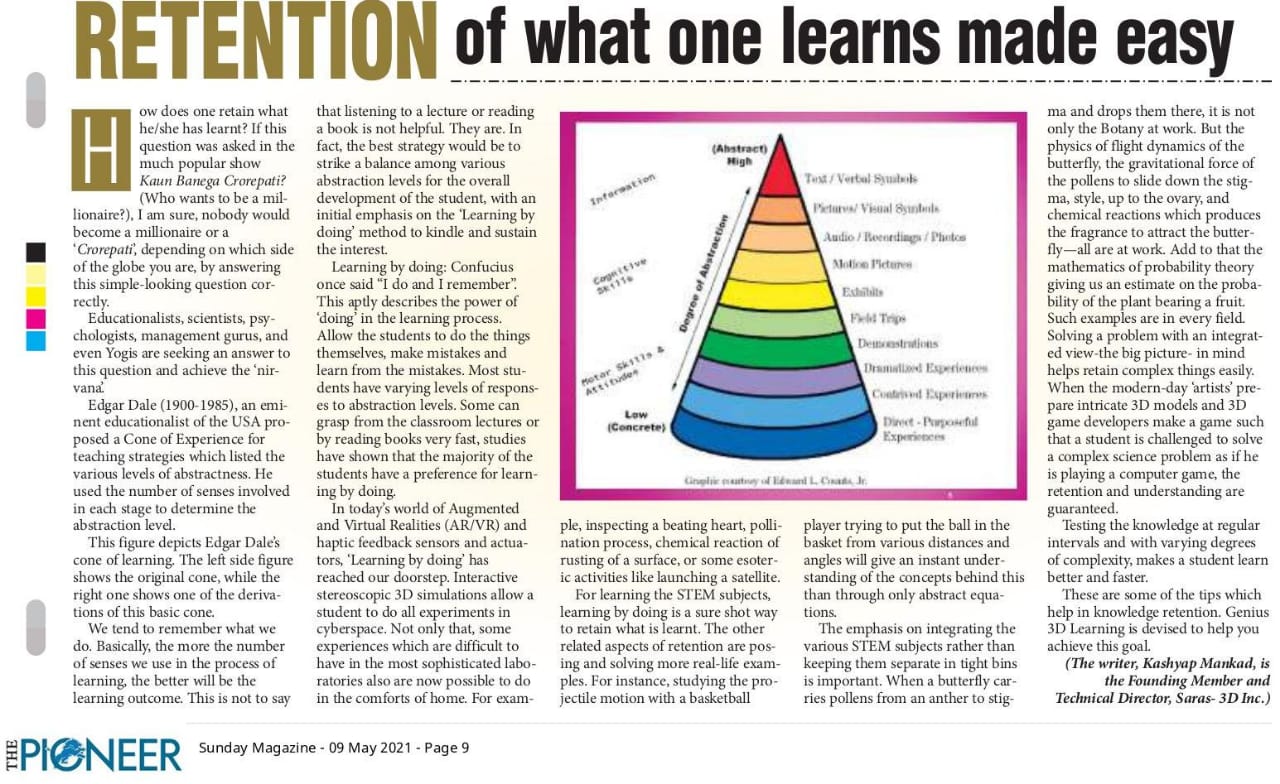NEWS
Saras-3D is a unique hands-on learning solution which allows students to interact with virtual objects and really understand the science behind them . It is designed to help 9th to 12th graders excel in science and mathematics more efficiently by picking up style of learning that allows them to "learn by doing"

Retention of what one learns made easy
Pioneer published an article written by Mr. Kashayap Mankad, Technical Director at Saras-3D. Article Publish date: 9th May, 2021.
How can one retain what one learns?
If this question was asked in the “Kaun Banega Karod-pati?” (“Who wants to be a millionaire?”), I am sure, nobody would become a millionaire or a ‘Karod-pati’ depending on which side of the globe you are, by answering this simple looking question correctly.
Educationalists, scientists, psychologists, management gurus and even Yogis are seeking an answer to this question and achieve the ‘nirvana’.
Edgar Dale (1900-1985), an eminent educationalist of the USA gave a Cone of Experience for teaching strategies which listed the various levels of abstractness, starting from the concrete experience at the bottom to the most abstract at the top. He used the number of senses involved in each stage to determine abstraction level.
The figure 1 depicts Edgar Dale’s cone of learning. The left side figure shows the original cone, while the right one shows one of the derivations of the basic cone.
Image courtesy: https://teachernoella.weebly.com/dales-cone-of-experience.html
Fig. 1: Edgar Dale’s cone of learning
We tend to remember what we do. Basically, more the number of senses we use in the process of learning, better will be the learning outcome. This is not to say that listening to a lecture or reading a book is not helpful. They are. In fact, the best strategy would be to strike a balance among various abstraction levels for overall development of the student, with initial emphasis on ‘Learning by doing’ method to kindle and sustain the interest.
Learning by doing: Confucius once said ”… I do and I remember”. This aptly describes the power of ‘doing’ in the learning process. Allow the students to do the things themselves, make mistakes and learn from the mistakes. This method is infinitely better than the drab lectures where the only purpose served is that the information written in the lecturer’s notebook are transferred to the students’ notebook without any absorption of information in between. This, of course, is a rare, extreme phenomena. Most students have varying levels of responses to abstraction levels. Some can rasp from the classroom lectures or by reading books/visiting internet very fast, studies have shown that majority of the students have preference for learning by doing.
We have five sensory perceptions namely, sight, sound, smell, taste and touch. In a Chemistry lab, a student may use four of these, except taste, to identify a chemical. But in the Physics and Biology labs, taste and smell are not normally required.
In today’s world of the cyberspace, the Augmented and Virtual Realities (AR/VR) and haptic feedback sensors and actuators, ‘Learning by doing’ has reached our doorstep. Interactive stereoscopic 3D simulations allow a student to do all experiment in the cyberspace. Not only that, some experiences which are difficult to have in the most sophisticated laboratories also are now possible to do in the comforts of home. For example, inspecting a beating heart, or pollination process, or chemical reaction happening during rusting of a surface or some esoteric activities like launching a satellite.
The very fact that you have visited this social media page/Website indicates your interest in the subject of ‘learning by doing’. Ask for any help.
For learning the STEM subjects, learning by doing is a sure shot way to retain what is learnt. The other related aspects of retention are posing and solving more real-life examples. For instance, studying the projectile motion with a basketball player trying to put the ball in the basket at various distances and angles will give instant understanding of the concepts behind this than through only abstract equations.
Apart from this, emphasis should be on integrating the various STEM subjects rather than keeping them separate in tight bins of Physics, Chemistry, Biology, Maths etc. When a butterfly carries pollens from an anther to stigma and drops them there, it is not only the Botany at work. But the physics of flight dynamics of the butterfly, gravitational force of the pollens to slide down the stigma, style, up to the ovary and chemical reactions which produces the fragrance to attract the butterfly—all are at work. Add to that the mathematics of probability theory giving us an estimate on the probability of the plant bearing a fruit. Such examples are in every field. Solving a problem with an integrated view-the big picture- in mind helps retain complex things easily. When the modern day ‘artists’ prepare intricate 3D models and 3D game developers make a game such that a student is challenged to solve a complex science problem as if he is playing a computer game, the retention and understanding are guaranteed.
Testing the knowledge at regular intervals and with varying degrees of complexity, makes a student learn better and faster. Tracking the progress cycle with powerful analytics tools makes the process foolproof.
These are some of the tips which help in knowledge retention. The Genius 3D Learning is devised to help you achieve this goal.
This article originally appeared in the Pioneer and is written by Mr. Kashayap Mankad, Technical Director at Saras-3D.